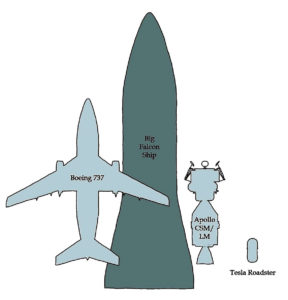Big Falcon Ship
The Big ‘Falcon’ Ship (BFS) is the first ever crewed Mars lander to actually begin construction. The vehicle is eventually intend¬ed to ferry dozens of crew to Mars simultaneously. Once on Mars, a propellant production plant will transform local resources into the Methane and Oxygen required to fuel the ship for its return to Earth. The entire ship is 48 m long, 9 m in diameter, and weighs 85 metric tons without fuel.
[imagelinks id=”7″]
Ships to Scale
While imposing, the BFS is nearly equal in size to the now retired US Space Shuttle.

